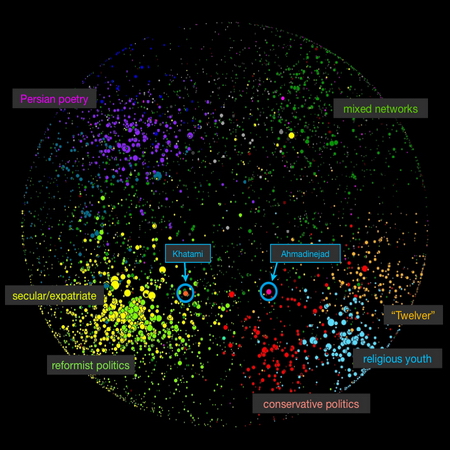In Harvard haben sich Forscher daran gemacht, eine Karte der äußerst lebendigen iranischen Blogosphäre zu erstellen. Dabei zeigt sich, dass Iran unter allen islamisch geprägten Ländern des Nahen Ostens eine einzigartige digitale Debattenkultur besitzt, in der Reformer mit Konservativen die Klingen kreuzen.
Aus der Zusammenfassung der Forscher:
„In contrast to the conventional wisdom that Iranian bloggers are mainly young democrats critical of the regime, we found a wide range of opinions representing religious conservative points of view as well as secular and reform-minded ones, and topics ranging from politics and human rights to poetry, religion, and pop culture. Our research indicates that the Persian blogosphere is indeed a large discussion space of approximately 60,000 routinely updated blogs featuring a rich and varied mix of bloggers. Social network analysis reveals the Iranian blogosphere to be dominated by four major network formations, or poles, with identifiable sub-clusters of bloggers within those poles. We label the poles as 1) Secular/Reformist, 2) Conservative/Religious, 3) Persian Poetry and Literature, and 4) Mixed Networks. (Click here for the map image.) The secular/reformist pole contains both expatriates and Iranians involved in a dialog about Iranian politics, among many other issues. The conservative/religious pole contains three distinct sub-clusters, two focused principally on religious issues and one on politics and current affairs. Given the repressive political and media environment, and high profile arrests and harassment of bloggers, one might not expect to find much political contestation in the blogosphere. However, we identified a subset of the secular/reformist pole focused intently on politics and current affairs and comprised mainly of bloggers living inside Iran, which is linked in contentious dialog with the conservative political sub-cluster. Surprisingly, a minority of bloggers in the secular/reformist pole appear to blog anonymously, even in the more politically-oriented part of it; instead, it is more common for bloggers in the religious/conservative pole to blog anonymously. Blocking of blogs by the government is less pervasive than we had assumed. Most of the blogosphere network is visible inside Iran, although the most frequently blocked blogs are clearly those in the secular/reformist pole.“
Ein Bericht der New York Times findet sich hier. Und hier die Website der Forscher mit den detaillierten Ergebnissen.
